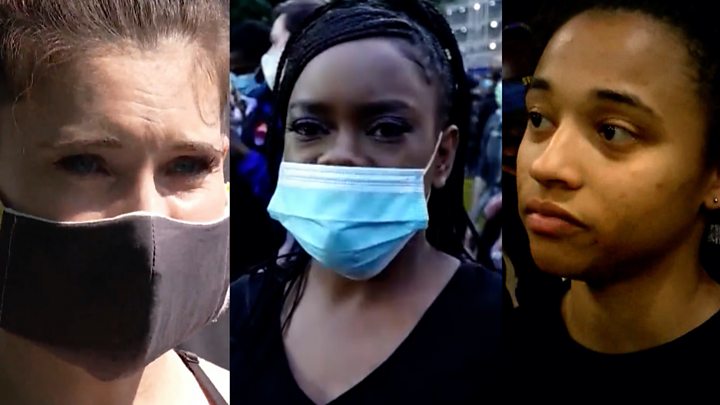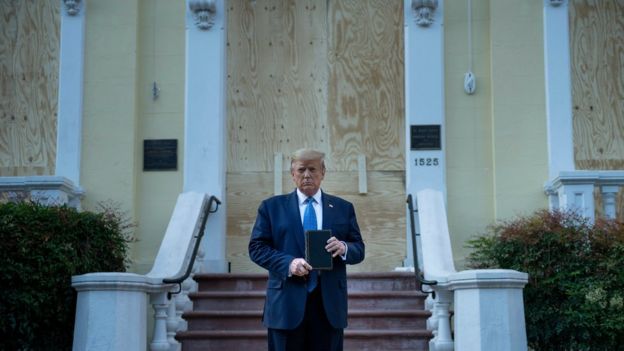Share the post "George Floyd death: Trump threatens to send in army to end unrest"
President Donald Trump has threatened to send in the military to quell growing civil unrest in the US over the death of a black man in police custody.
He said if cities and states failed to control the protests and “defend their residents” he would deploy the army and “quickly solve the problem for them”.
Protests over the death of George Floyd have escalated over the past week.
Presidential candidate Joe Biden criticised Mr Trump on Tuesday for “serving the passions of his base”.
“We’re not going to allow any president to quiet our voice,” the Democrat said, referencing the US constitution which guarantees protestors’ freedom to assemble.
On Tuesday the Las Vegas sheriff said an officer died in a shooting after police attempted to disperse a crowd.
Dozens of people have been injured as authorities used tear gas and force to disperse protests which have swept more than 75 cities.
Four officers meanwhile were shot and injured on Monday night during unrest in St Louis, Missouri.

George Floyd death
- Live updates from around the US
- CRIME AND JUSTICE: How are African-Americans treated?
- NEWS REPORTERS: A new target for police?
- DECEPTIVE FOOTAGE: Conspiracy theories spread online
- HOW IT HAPPENED: The last moments of his life

Dozens of major cities have imposed overnight curfews.
- In New York on Monday night, the iconic department store Macy’s was broken into, as shops were looted and windows smashed
- Curfew in the city will resume at 20:00 (midnight GMT) on Tuesday
- In Chicago, two people were reported killed amid unrest, although the circumstances are unclear
- The chief of police in Louisville, Kentucky has been sacked after law enforcement officers fired into a crowd on Sunday night, killing the owner of a nearby business
- Australian PM Scott Morrison has demanded an investigation into the alleged assault by police of two Australian journalists covering protests in Washington DC
- Music channels and celebrities have pledged to mark Blackout Tuesday, pausing for eight minutes – the length of time a police officer knelt on Mr Floyd’s neck

The protests began after a video showed Mr Floyd, 46, being arrested in Minneapolis on 25 May and a white police officer continuing to kneel on his neck even after he pleaded that he could not breathe.
The officer, Derek Chauvin, has been charged with third-degree murder and will appear in court next week. Three other police officers have been fired.
The Floyd case has reignited deep-seated anger over police killings of black Americans and racism. It follows the high-profile cases of Michael Brown in Ferguson, Missouri; Eric Garner in New York; and others that have driven the Black Lives Matter movement.
For many, the outrage also reflects years of frustration over socio-economic inequality and discrimination, not least in Minneapolis itself.
What did Trump say?
The president delivered a brief address from the White House Rose Garden, amid the sound of a nearby protest being dispersed.
Mr Trump said “all Americans were rightly sickened and revolted by the brutal death of George Floyd” but said his memory must not be “drowned out by an angry mob”.

He described the scenes of looting and violence in the capital on Sunday as “a total disgrace” before pledging to bolster the city’s defences.
“I’m dispatching thousands and thousands of heavily armed soldiers, military personnel and law enforcement officers to stop the rioting, looting, vandalism, assaults and the wanton destruction of property,” he said.

He called on cities and states to deploy the National Guard, the reserve military force that can be called on to intervene in domestic emergencies, “in sufficient numbers that we dominate the streets”. About 16,000 troops have been deployed so far.
Mr Trump added: “If a city or state refuses to take the actions that are necessary… then I’ll deploy the United States military and quickly solve the problem for them.”
Can he do that?
In order to take that step, the president would have to invoke the Insurrection Act, which in some circumstances first requires a request from state governors for him to do so.
This law was last invoked in 1992 during riots in Los Angeles following the acquittal of four police officers charged with assaulting black motorist Rodney King.
Mr Trump’s warning was met with swift criticism from senior Democrats. Joe Biden, the party’s presumptive presidential candidate, said Mr Trump “[was] using the American military against the American people”.
Following his address, Mr Trump walked to a nearby church which had been damaged by protesters on Sunday night. He and a number of aides stood at the steps of the building as Mr Trump held up a Bible in front of the gathered press.

His actions were condemned by Washington’s Episcopalian bishop, Mariann Budde.
“He took the symbols sacred to our tradition and stood in front of a house of prayer in full expectation that would be a celebratory moment,” she said.
“There was nothing I could do but speak out against that.”

An escalation of force?

Throughout Monday, pressure grew on Donald Trump to take action to address the rising unrest in major cities across the US. As the sun set in Washington DC, in a hastily arranged Rose Garden address, the president outlined what that action would be.
Governors were warned that if they did not effectively secure property and safety on the streets, the president would cite a centuries-old law to dispatch the US Army on American soil. And in the District of Columbia, which is under federal authority, the president had already ordered the military to deploy in force.
Moments before the president spoke, promising he was on the side of peaceful protesters, those armed soldiers cleared out peaceful protesters from Lafayette Square, across the street from the White House.
It set the stage for the president to walk with his senior staff across the park to St John’s Church, which was lightly damaged in a fire set by rioters the previous evening – an important symbolic gesture or an unnecessary photo opportunity, depending on one’s perspective. Posing in front of the building with a Bible, he promised that America was “coming back strong” and “it won’t take long”.
There was no talk of police reforms or the root causes of the protests that began last week at any point in the evening’s proceedings. Instead, he said he was the “president of law and order” – a sign, it seems, that his solution to the ongoing crisis will be an escalation of force.
bbc